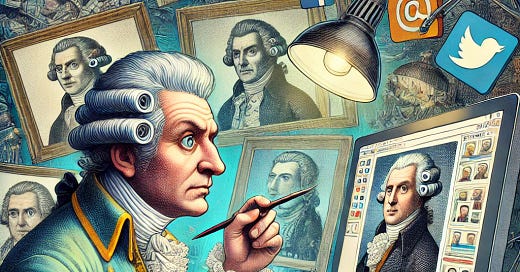James Gillray: The Satirical Eye of Georgian Britain in the Digital Age
Past Forward: Historical Icons in the Digital Frontier #45
Voice-over provided by Amazon Polly
Also, check out Eleven Labs, which we use for all our fiction.
Preface
Welcome to another installment of Past Forward: Historical Icons in the Digital Frontier. In this entry, we reimagine James Gillray, the legendary English caricaturist, encountering the hyperconnected, meme-driven culture of today. Gillray's biting satirical prints once lambasted the political elite of Georgian Britain, using humor and exaggeration to expose hypocrisy and folly. What would he make of a world where political cartoons have become digital memes, and where satire shapes narratives on a global scale? Join us as we explore Gillray’s modern-day journey, uncovering how his art and wit might resonate—and adapt—in the 21st century.
Introduction
James Gillray awakens to a cacophony of digital notifications. His bewildered eyes scan the glowing screens of smartphones and tablets in a bustling café. The caricaturist, whose pen once wielded immense political influence, now finds himself in a world where public opinion is shaped in seconds by trending tweets and viral videos.
Peering over shoulders, he observes bold headlines, satirical memes, and animated GIFs skewering politicians, celebrities, and corporations alike. The tools are different—pixels instead of ink, screens instead of prints—but the spirit of satire is unmistakably alive. Intrigued, Gillray dives headfirst into the vibrant world of modern political commentary, eager to see how his craft has evolved and how he might contribute.
Historical Context and Modern Connection
In the late 18th and early 19th centuries, James Gillray revolutionized political satire. His etched prints, hand-colored and sold in London’s shops, became cultural phenomena. Works like The Plumb-pudding in Danger lampooned figures like Napoleon and Pitt the Younger with sharp wit and vivid exaggeration, influencing public opinion and solidifying caricature as a form of political discourse.
Gillray’s era was one of profound political and social upheaval. The French Revolution, Napoleonic Wars, and rising tensions within Britain created fertile ground for satire. His art captured the anxieties and absurdities of his time, holding a mirror to a society grappling with change. The industrial revolution was also beginning to reshape social structures, introducing class tensions and a growing disparity between the rich and poor. With his incisive humor, Gillray bridged the gap between art and political commentary, making complex issues accessible to a broad audience and challenging both the elite and the status quo.
Gillray’s works were more than entertainment; they were powerful instruments of political messaging. At a time when newspapers and printed texts often carried overt biases, his visual satires could distill complex ideas into instantly understandable images. Whether critiquing war policies or mocking royal extravagance, his art offered a unique commentary that resonated widely. His sharp wit ensured that no one—from monarchs to revolutionaries—escaped his scrutiny, making him both feared and admired.
Fast-forward to today, and Gillray would find himself at home in a digital landscape where humor and satire are pivotal tools for critiquing authority. Memes and digital art often echo the sharp humor and visual flair that defined his work. The rapid pace of content creation and distribution on platforms like Twitter and Instagram allows satire to spread further and faster than ever before, amplifying its influence on public opinion. From social media to editorial cartoons, his legacy lives on in the way satire holds power to account and gives voice to dissent, serving as a reminder that art and humor remain vital tools for challenging injustice and inspiring debate.
Exploring Modern Innovations
Gillray’s fascination with technology is immediate. In a graphic design studio, he marvels at digital illustration tools that allow for vibrant colors, layers, and precise edits, far removed from the painstaking process of etching plates and hand-coloring prints. Watching a designer effortlessly manipulate an image on-screen leaves him in awe. Given a stylus and a tablet, he experiments with drawing apps, exploring features like brush customization and 3D rendering. Translating his iconic style into a digital medium, Gillray quickly discovers that his sharp lines and exaggerated expressions adapt effortlessly to new formats like GIFs and animated shorts. The ability to revise and experiment without damaging the final piece is a revelation, one that transforms his creative process.
Exploring social media, Gillray is stunned by the speed at which satire circulates. A meme mocking a politician’s speech can reach millions within hours—a scale unimaginable in his time. He delves into platforms like Twitter and TikTok, observing how humor is used to critique everything from international policies to pop culture. From snappy text overlays to lip-synced parodies, Gillray marvels at the ingenuity of modern creators. Inspired, he begins creating his own content, blending his historical style with modern themes. His satirical takes on global politics—delivered with his trademark wit and biting edge—quickly go viral, earning praise for their timeless relevance.
Gillray becomes intrigued by live-streaming technology, where creators interact directly with their audiences. He launches a weekly satire session, sketching in real time while discussing current events with viewers. The interactive format allows him to explain his process, engage in debates, and even take audience suggestions for subjects to lampoon. This newfound immediacy strengthens his connection with modern audiences and gives him a deeper understanding of their concerns.
He collaborates with animators to create short videos that reinterpret his classic works. A modern version of The Plumb-pudding in Danger features global leaders negotiating climate policy over a shrinking Earth, while another animation lampoons corporate greed by placing Victorian-era industrialists in contemporary boardrooms. These projects become cultural phenomena, praised for their sharp wit, historical nods, and timely commentary. Gillray also explores virtual reality (VR), where users can step inside satirical worlds he creates, interacting with exaggerated figures and surreal landscapes that critique modern society. This immersive approach offers audiences a visceral experience of his art, blurring the lines between satire and storytelling.
Ethical Reflections and Societal Impact
Gillray’s return sparks questions about the ethics of satire in the digital age. While his own work often veered into cruel exaggerations, he is struck by the toxicity of online discourse, where satire sometimes devolves into personal attacks or misinformation. Reflecting on the responsibility of satirists, he advocates for a balance between sharp critique and fairness.
He also recognizes the power of satire to challenge authoritarianism and inspire change. Gillray collaborates with modern activists, using his art to highlight issues like climate change, wealth inequality, and digital privacy. His ability to distill complex issues into compelling visuals resonates, reminding audiences of satire’s enduring role in shaping societal debates.
Gillray debates with online communities about the fine line between satire and defamation. He questions the role of algorithms in amplifying divisive content, exploring how technology can both elevate and distort the satirist’s voice. His discussions inspire a movement advocating for ethical satire, emphasizing truthfulness and accountability in digital commentary.
Collaborative Contributions
Working with digital artists and animators, Gillray leads a project to modernize his most famous prints, adapting them into interactive formats. Imagine The Plumb-pudding in Danger reimagined as an augmented reality (AR) experience, where users can manipulate characters and settings to reflect contemporary geopolitics. This project extends into virtual exhibitions, where viewers can navigate entire rooms filled with reinterpreted historical caricatures brought to life with soundscapes and animations. These exhibitions become hubs of discussion, drawing visitors eager to explore the parallels between Gillray's era and the modern world.
Gillray also mentors young satirists, encouraging them to harness humor as a tool for social critique. His workshops emphasize the importance of historical knowledge in crafting effective satire, blending timeless techniques with cutting-edge technology. He incorporates hands-on sessions where participants use digital tools to create caricatures, with topics ranging from environmental issues to political scandals. These sessions often evolve into collaborative projects, with Gillray acting as both a guide and a co-creator.
Expanding his influence, Gillray becomes a sought-after speaker at conferences on digital art and media ethics. His presentations delve into the intersection of historical satire and contemporary issues, offering unique perspectives on how the lessons of the past can inform modern media practices. He also contributes to podcasts and panel discussions, sharing anecdotes from his 18th-century career while drawing surprising comparisons to the 21st-century media landscape. His insights inspire new waves of creators to approach satire with both innovation and responsibility.
Gillray’s influence reaches the world of education, where he collaborates with universities to develop courses on satirical art and its societal impact. Students study his original works alongside modern memes and political cartoons, analyzing their techniques and cultural significance. Through these academic partnerships, Gillray ensures that the art of satire remains a vital part of contemporary discourse, empowering future generations to challenge authority and spark meaningful dialogue.
Conclusion: Legacy and Modern Influence
As Gillray reflects on his journey, he marvels at how satire has evolved while remaining true to its core purpose: speaking truth to power. He sees his legacy not just in the galleries that preserve his prints but in every meme, cartoon, and digital artwork that dares to challenge authority and provoke thought.
Gillray leaves the modern world with a renewed sense of purpose, knowing that the spirit of satire—humorous yet piercing, critical yet creative—will continue to thrive. His story reminds us that in every era, art and wit can illuminate the complexities of power and hold a mirror to society’s triumphs and follies.
Thank you for your time today. Until next time, stay gruntled.
Do you like what you read but aren’t yet ready or able to get a paid subscription? Then consider a one-time tip at:
https://www.venmo.com/u/TheCogitatingCeviche
Ko-fi.com/thecogitatingceviche








James, I loved this piece on James Gillray. It made me think of a Victorian artistic satrist and caricaturist, John Tenniell. He worked for "Punch" magazine and took great chances making his drawngs of people like Queen Victoria and Benjamin Disraeli.
Who would have thought that he would have become the world's most famous illustrator of the two classic children's books, ALICE IN WONDERLAND and its companion book ALICE THROUGH THE LOOKING GLASS. In the later book, there's a wonderful drawng of Alice in a train car sitting with a man dressed in white paper who is Disraeli.
Thank you for this insight into James Gillray, as you can see it set my mind working on overtime.